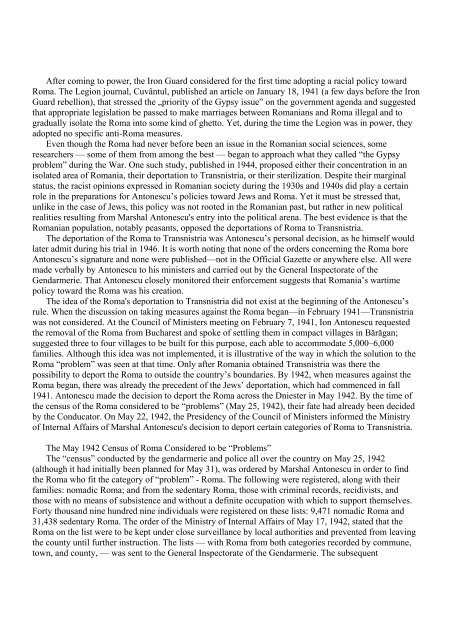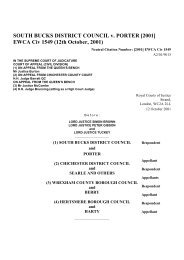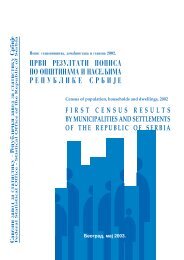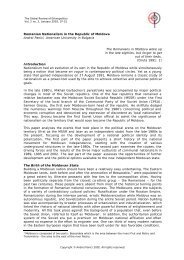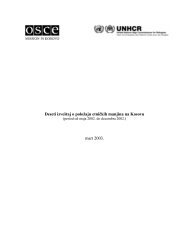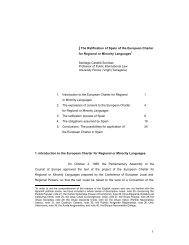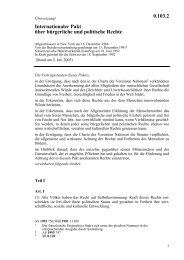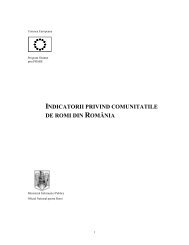Final Report of the International Commission on the - Minority Rights ...
Final Report of the International Commission on the - Minority Rights ...
Final Report of the International Commission on the - Minority Rights ...
Create successful ePaper yourself
Turn your PDF publications into a flip-book with our unique Google optimized e-Paper software.
After coming to power, <str<strong>on</strong>g>the</str<strong>on</strong>g> Ir<strong>on</strong> Guard c<strong>on</strong>sidered for <str<strong>on</strong>g>the</str<strong>on</strong>g> first time adopting a racial policy toward<br />
Roma. The Legi<strong>on</strong> journal, Cuvântul, published an article <strong>on</strong> January 18, 1941 (a few days before <str<strong>on</strong>g>the</str<strong>on</strong>g> Ir<strong>on</strong><br />
Guard rebelli<strong>on</strong>), that stressed <str<strong>on</strong>g>the</str<strong>on</strong>g> „priority <str<strong>on</strong>g>of</str<strong>on</strong>g> <str<strong>on</strong>g>the</str<strong>on</strong>g> Gypsy issue” <strong>on</strong> <str<strong>on</strong>g>the</str<strong>on</strong>g> government agenda and suggested<br />
that appropriate legislati<strong>on</strong> be passed to make marriages between Romanians and Roma illegal and to<br />
gradually isolate <str<strong>on</strong>g>the</str<strong>on</strong>g> Roma into some kind <str<strong>on</strong>g>of</str<strong>on</strong>g> ghetto. Yet, during <str<strong>on</strong>g>the</str<strong>on</strong>g> time <str<strong>on</strong>g>the</str<strong>on</strong>g> Legi<strong>on</strong> was in power, <str<strong>on</strong>g>the</str<strong>on</strong>g>y<br />
adopted no specific anti-Roma measures.<br />
Even though <str<strong>on</strong>g>the</str<strong>on</strong>g> Roma had never before been an issue in <str<strong>on</strong>g>the</str<strong>on</strong>g> Romanian social sciences, some<br />
researchers — some <str<strong>on</strong>g>of</str<strong>on</strong>g> <str<strong>on</strong>g>the</str<strong>on</strong>g>m from am<strong>on</strong>g <str<strong>on</strong>g>the</str<strong>on</strong>g> best — began to approach what <str<strong>on</strong>g>the</str<strong>on</strong>g>y called “<str<strong>on</strong>g>the</str<strong>on</strong>g> Gypsy<br />
problem” during <str<strong>on</strong>g>the</str<strong>on</strong>g> War. One such study, published in 1944, proposed ei<str<strong>on</strong>g>the</str<strong>on</strong>g>r <str<strong>on</strong>g>the</str<strong>on</strong>g>ir c<strong>on</strong>centrati<strong>on</strong> in an<br />
isolated area <str<strong>on</strong>g>of</str<strong>on</strong>g> Romania, <str<strong>on</strong>g>the</str<strong>on</strong>g>ir deportati<strong>on</strong> to Transnistria, or <str<strong>on</strong>g>the</str<strong>on</strong>g>ir sterilizati<strong>on</strong>. Despite <str<strong>on</strong>g>the</str<strong>on</strong>g>ir marginal<br />
status, <str<strong>on</strong>g>the</str<strong>on</strong>g> racist opini<strong>on</strong>s expressed in Romanian society during <str<strong>on</strong>g>the</str<strong>on</strong>g> 1930s and 1940s did play a certain<br />
role in <str<strong>on</strong>g>the</str<strong>on</strong>g> preparati<strong>on</strong>s for Ant<strong>on</strong>escu’s policies toward Jews and Roma. Yet it must be stressed that,<br />
unlike in <str<strong>on</strong>g>the</str<strong>on</strong>g> case <str<strong>on</strong>g>of</str<strong>on</strong>g> Jews, this policy was not rooted in <str<strong>on</strong>g>the</str<strong>on</strong>g> Romanian past, but ra<str<strong>on</strong>g>the</str<strong>on</strong>g>r in new political<br />
realities resulting from Marshal Ant<strong>on</strong>escu's entry into <str<strong>on</strong>g>the</str<strong>on</strong>g> political arena. The best evidence is that <str<strong>on</strong>g>the</str<strong>on</strong>g><br />
Romanian populati<strong>on</strong>, notably peasants, opposed <str<strong>on</strong>g>the</str<strong>on</strong>g> deportati<strong>on</strong>s <str<strong>on</strong>g>of</str<strong>on</strong>g> Roma to Transnistria.<br />
The deportati<strong>on</strong> <str<strong>on</strong>g>of</str<strong>on</strong>g> <str<strong>on</strong>g>the</str<strong>on</strong>g> Roma to Transnistria was Ant<strong>on</strong>escu’s pers<strong>on</strong>al decisi<strong>on</strong>, as he himself would<br />
later admit during his trial in 1946. It is worth noting that n<strong>on</strong>e <str<strong>on</strong>g>of</str<strong>on</strong>g> <str<strong>on</strong>g>the</str<strong>on</strong>g> orders c<strong>on</strong>cerning <str<strong>on</strong>g>the</str<strong>on</strong>g> Roma bore<br />
Ant<strong>on</strong>escu’s signature and n<strong>on</strong>e were published—not in <str<strong>on</strong>g>the</str<strong>on</strong>g> Official Gazette or anywhere else. All were<br />
made verbally by Ant<strong>on</strong>escu to his ministers and carried out by <str<strong>on</strong>g>the</str<strong>on</strong>g> General Inspectorate <str<strong>on</strong>g>of</str<strong>on</strong>g> <str<strong>on</strong>g>the</str<strong>on</strong>g><br />
Gendarmerie. That Ant<strong>on</strong>escu closely m<strong>on</strong>itored <str<strong>on</strong>g>the</str<strong>on</strong>g>ir enforcement suggests that Romania’s wartime<br />
policy toward <str<strong>on</strong>g>the</str<strong>on</strong>g> Roma was his creati<strong>on</strong>.<br />
The idea <str<strong>on</strong>g>of</str<strong>on</strong>g> <str<strong>on</strong>g>the</str<strong>on</strong>g> Roma's deportati<strong>on</strong> to Transnistria did not exist at <str<strong>on</strong>g>the</str<strong>on</strong>g> beginning <str<strong>on</strong>g>of</str<strong>on</strong>g> <str<strong>on</strong>g>the</str<strong>on</strong>g> Ant<strong>on</strong>escu’s<br />
rule. When <str<strong>on</strong>g>the</str<strong>on</strong>g> discussi<strong>on</strong> <strong>on</strong> taking measures against <str<strong>on</strong>g>the</str<strong>on</strong>g> Roma began—in February 1941—Transnistria<br />
was not c<strong>on</strong>sidered. At <str<strong>on</strong>g>the</str<strong>on</strong>g> Council <str<strong>on</strong>g>of</str<strong>on</strong>g> Ministers meeting <strong>on</strong> February 7, 1941, I<strong>on</strong> Ant<strong>on</strong>escu requested<br />
<str<strong>on</strong>g>the</str<strong>on</strong>g> removal <str<strong>on</strong>g>of</str<strong>on</strong>g> <str<strong>on</strong>g>the</str<strong>on</strong>g> Roma from Bucharest and spoke <str<strong>on</strong>g>of</str<strong>on</strong>g> settling <str<strong>on</strong>g>the</str<strong>on</strong>g>m in compact villages in Bărăgan;<br />
suggested three to four villages to be built for this purpose, each able to accommodate 5,000–6,000<br />
families. Although this idea was not implemented, it is illustrative <str<strong>on</strong>g>of</str<strong>on</strong>g> <str<strong>on</strong>g>the</str<strong>on</strong>g> way in which <str<strong>on</strong>g>the</str<strong>on</strong>g> soluti<strong>on</strong> to <str<strong>on</strong>g>the</str<strong>on</strong>g><br />
Roma “problem” was seen at that time. Only after Romania obtained Transnistria was <str<strong>on</strong>g>the</str<strong>on</strong>g>re <str<strong>on</strong>g>the</str<strong>on</strong>g><br />
possibility to deport <str<strong>on</strong>g>the</str<strong>on</strong>g> Roma to outside <str<strong>on</strong>g>the</str<strong>on</strong>g> country’s boundaries. By 1942, when measures against <str<strong>on</strong>g>the</str<strong>on</strong>g><br />
Roma began, <str<strong>on</strong>g>the</str<strong>on</strong>g>re was already <str<strong>on</strong>g>the</str<strong>on</strong>g> precedent <str<strong>on</strong>g>of</str<strong>on</strong>g> <str<strong>on</strong>g>the</str<strong>on</strong>g> Jews’ deportati<strong>on</strong>, which had commenced in fall<br />
1941. Ant<strong>on</strong>escu made <str<strong>on</strong>g>the</str<strong>on</strong>g> decisi<strong>on</strong> to deport <str<strong>on</strong>g>the</str<strong>on</strong>g> Roma across <str<strong>on</strong>g>the</str<strong>on</strong>g> Dniester in May 1942. By <str<strong>on</strong>g>the</str<strong>on</strong>g> time <str<strong>on</strong>g>of</str<strong>on</strong>g><br />
<str<strong>on</strong>g>the</str<strong>on</strong>g> census <str<strong>on</strong>g>of</str<strong>on</strong>g> <str<strong>on</strong>g>the</str<strong>on</strong>g> Roma c<strong>on</strong>sidered to be “problems” (May 25, 1942), <str<strong>on</strong>g>the</str<strong>on</strong>g>ir fate had already been decided<br />
by <str<strong>on</strong>g>the</str<strong>on</strong>g> C<strong>on</strong>ducator. On May 22, 1942, <str<strong>on</strong>g>the</str<strong>on</strong>g> Presidency <str<strong>on</strong>g>of</str<strong>on</strong>g> <str<strong>on</strong>g>the</str<strong>on</strong>g> Council <str<strong>on</strong>g>of</str<strong>on</strong>g> Ministers informed <str<strong>on</strong>g>the</str<strong>on</strong>g> Ministry<br />
<str<strong>on</strong>g>of</str<strong>on</strong>g> Internal Affairs <str<strong>on</strong>g>of</str<strong>on</strong>g> Marshal Ant<strong>on</strong>escu's decisi<strong>on</strong> to deport certain categories <str<strong>on</strong>g>of</str<strong>on</strong>g> Roma to Transnistria.<br />
The May 1942 Census <str<strong>on</strong>g>of</str<strong>on</strong>g> Roma C<strong>on</strong>sidered to be “Problems”<br />
The “census” c<strong>on</strong>ducted by <str<strong>on</strong>g>the</str<strong>on</strong>g> gendarmerie and police all over <str<strong>on</strong>g>the</str<strong>on</strong>g> country <strong>on</strong> May 25, 1942<br />
(although it had initially been planned for May 31), was ordered by Marshal Ant<strong>on</strong>escu in order to find<br />
<str<strong>on</strong>g>the</str<strong>on</strong>g> Roma who fit <str<strong>on</strong>g>the</str<strong>on</strong>g> category <str<strong>on</strong>g>of</str<strong>on</strong>g> “problem” - Roma. The following were registered, al<strong>on</strong>g with <str<strong>on</strong>g>the</str<strong>on</strong>g>ir<br />
families: nomadic Roma; and from <str<strong>on</strong>g>the</str<strong>on</strong>g> sedentary Roma, those with criminal records, recidivists, and<br />
those with no means <str<strong>on</strong>g>of</str<strong>on</strong>g> subsistence and without a definite occupati<strong>on</strong> with which to support <str<strong>on</strong>g>the</str<strong>on</strong>g>mselves.<br />
Forty thousand nine hundred nine individuals were registered <strong>on</strong> <str<strong>on</strong>g>the</str<strong>on</strong>g>se lists: 9,471 nomadic Roma and<br />
31,438 sedentary Roma. The order <str<strong>on</strong>g>of</str<strong>on</strong>g> <str<strong>on</strong>g>the</str<strong>on</strong>g> Ministry <str<strong>on</strong>g>of</str<strong>on</strong>g> Internal Affairs <str<strong>on</strong>g>of</str<strong>on</strong>g> May 17, 1942, stated that <str<strong>on</strong>g>the</str<strong>on</strong>g><br />
Roma <strong>on</strong> <str<strong>on</strong>g>the</str<strong>on</strong>g> list were to be kept under close surveillance by local authorities and prevented from leaving<br />
<str<strong>on</strong>g>the</str<strong>on</strong>g> county until fur<str<strong>on</strong>g>the</str<strong>on</strong>g>r instructi<strong>on</strong>. The lists — with Roma from both categories recorded by commune,<br />
town, and county, — was sent to <str<strong>on</strong>g>the</str<strong>on</strong>g> General Inspectorate <str<strong>on</strong>g>of</str<strong>on</strong>g> <str<strong>on</strong>g>the</str<strong>on</strong>g> Gendarmerie. The subsequent


